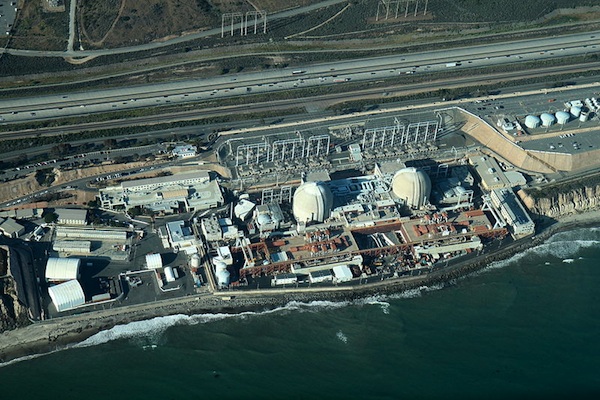
Angeles Chapter leaders and environmental activists met with officials of the Nuclear Regulatory Commission (NRC) in September to share concerns about decommissioning San Onofre nuclear power plant, particularly over the issue of storing spent nuclear fuel. Local environmental and citizens groups, including the Sierra Club's San Onofre Task Force, have been key advocates for environmental and ratepayer issues.
These activists learned recently from NRC sources that high burnup fuel has been used at San Onofre since 1996. This fuel is enriched with more radioactive Uranium 235 than the conventional nuclear fuel used previously at San Onofre. High burnup fuel releases more heat and is at least twice as radioactive as conventional fuel. This requires spent fuel to be cooled on-site in water-filled pools for 12 to 15 years rather than 5 years for conventional nuclear fuel used previously. Once spent nuclear fuel cools enough, it can be transferred to dry cask storage onsite.
"I was shocked to learn San Onofre, as well as other plants in California and around the country, have been using high burnup fuel that has no approved short or long term safe storage solution," San Clemente activist Donna Gilmore said.
Activists list concerns over what happens next
On September 26 the NRC held a two-hour meeting with the Sierra Club and other local activists. The meeting was chaired by Larry Camper, director of the NRC Waste Management and Environmental Protection Division, and included about a dozen NRC officials including Bruce Watson, NRC Reactor Decommissioning Branch Chief, and Mary Woollen, policy advisor to NRC Chairman Allison M. Macfarlane. Glenn Pascall, Chair of the San Onofre Task Force and George Watland, Conservation Program Coordinator, represented the Angeles Chapter and were joined by Gene Stone and Donna Gilmore heading organizations that are working on San Onofre issues.
Watson indicated that the NRC is collecting information and conducting a storage demonstration project with the nuclear power industry to determine if high burnup fuel can safely be stored in dry casks for more than the 20 years it currently approves for conventional nuclear fuel. Camper confirmed that no long-term off-site storage is yet available in the US for either conventional or high burnup spent fuel.
Some questions raised during the meeting included:
• What specific problems does this higher radioactive fuel present for waste storage in fuel pools and dry cask storage at San Onofre and how much longer will a high level of radiation last?
• How will decommissioning be impacted by the current onsite storage of the spent fuel at San Onofre?
• How does the NRC propose to monitor the condition of the highly radioactive material stored inside dry casks?
• How many casks will be required to safely store all the high burnup fuel that is on site in both the spent fuel pools and dry casks at San Onofre?
Camper indicated that specific answers to these questions and others about decommissioning the San Onofre plant will be addressed by its licensed operator, Southern California Edison, in the “Post Shutdown Decommissioning Activities Report (PSDAR)" required by June 2015. However, he agreed that activists' concerns about high burnup fuel storage deserve more attention and suggested that the NRC will conduct additional local meetings on the subject in the near future.
As Gene Stone of Residents Organized for Safe Environment (ROSE) commented, "We may be a little safer with San Onofre closed, but we are not safe yet."
Join us for Decomissioning San Onofre forum
To help inform ratepayers and the public about the issues affecting the decommissioning process at San Onofre, the Angeles Chapter San Onofre Task Force will co-sponsor a Community Symposium on Decommissioning San Onofre from 1:30 to 4:30 p.m., Saturday, October 19 at the Center for Spiritual Living, 1201 Puerta Del Sol, Suite 100, San Clemente, CA 92673. Other co-sponsors include Residents Organized for a Safe Environment (ROSE), Peace Resource Center of San Diego, San Clemente Green, Women's Occupy, Citizens Oversight.
Featured speakers include Arjun Makhijani, expert on the hardened on-site storage of nuclear waste and long-term high-level waste management issues, and President of the Institute for Energy and Environmental Research; Marvin Resnikoff, expert on nuclear waste management issues, and senior associate at Radioactive Waste Management Associates; and Dr. Donald Mosier of the Department of Immunology at Scripps Research Institute and City Council member of Del Mar, California. More information about the symposium can be found at the Angeles Chapter website.
In January 2012, the San Onofre Nuclear Generating Station was shut down due to radiation leaks. Upgrades to two units were made in 2009 but premature wear found on tubes used at the site forced the closure. Sen. Barbara Boxer, D-Calif., said in May 2013 that the nuclear generator was "unsafe and posed a danger to the 8 million people living within 50 miles of the plant.” Power operator Southern California Edison on June 7 announced that the plant would be permanently decommissioned.
Glenn Pascall, Gene Stone and Donna Gilmore contributed to this story.
Photo: Aerial view of the San Onofre nuclear power plant.